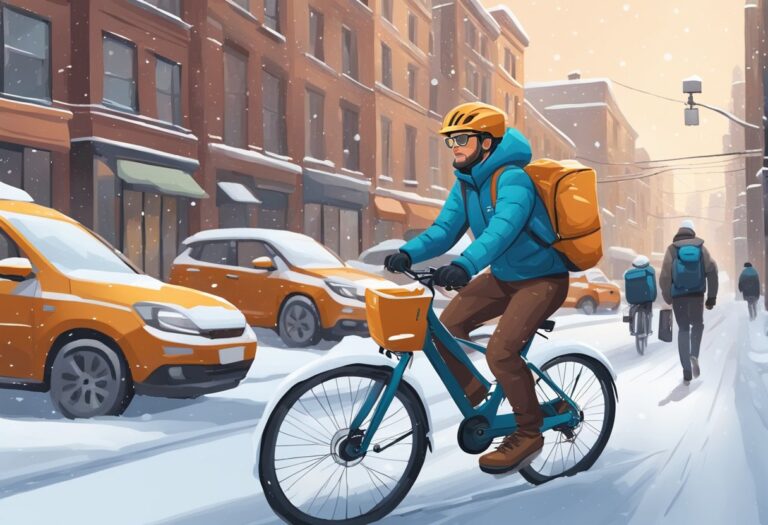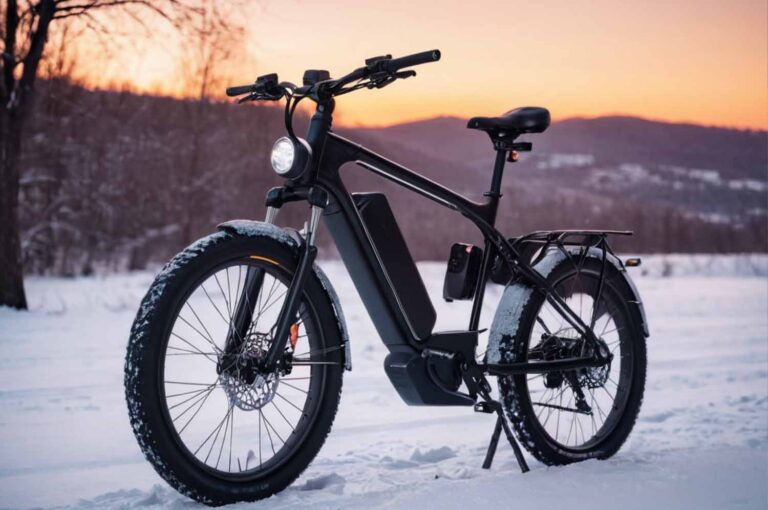Student’s Guide to Winter E-Biking: Costs, Convenience, & Proper Care
E-biking in winter presents students with a unique set of challenges and opportunities, particularly for those navigating the bustling streets of cities like New York.
With the advent of electric bicycles, cycling in cold weather has become more accessible and appealing.
Electric bikes offer a cost-effective and efficient means of transportation, sidestepping the usual challenges of winter commuting such as delays and crowded public transport.
Maintaining an e-bike during winter in a place like New York requires understanding the impact of cold weather on battery performance and the necessary care to ensure longevity.
Students must also be well-equipped with the right clothing and accessories for safe and warm travel.
The convenience of e-bikes allows for an easy transition from cycling in milder conditions to managing the slushy streets and freezing temperatures characteristic of a New York winter.
Cost considerations are crucial for students who must balance the benefits of e-biking with the expenses of maintaining their bikes in good condition during the winter months.
From special tires to enhanced lighting and proper battery storage, the upfront costs to the ongoing savings on public transport fares and the long-term health benefits of an active lifestyle.
The overall value proposition of winter e-biking for students is measured not only in dollars and cents but also in the added autonomy and reliability it provides amidst the winter elements.
Table of Contents
Understanding E-Biking
When considering an e-bike for winter cycling, one should be mindful that the benefits extend beyond the summer months, and there are specific types designed to handle the challenges of colder weather.
Benefits of E-Biking in Winter
E-biking during the winter has its unique advantages. Not only does it provide an efficient way to navigate through snowy conditions, but it also offers health benefits by keeping riders active throughout the year.
Moreover, it can be a more reliable transportation method, especially when roads are difficult for regular vehicles to traverse.
For instance, an electric bike’s battery cannot charge below freezing, which means riders must plan accordingly to maintain their bike’s performance in cold weather.
Types of E-Bikes Suitable for Winter
Selecting the right type of e-bike for winter use is crucial.
The most suitable e-bikes are those with fat tires and high-quality components that can withstand the rigors of cold and wet conditions.
Fat-tire e-bikes, in particular, offer improved grip and stability on snowy roads.
It’s important for the rider to ensure their e-bike and its battery are well maintained and protected from extreme temperatures, as proper care prolongs the e-bike’s lifespan.
By understanding these key aspects of e-biking, students can make informed decisions and enjoy the numerous benefits of cycling during the colder months with confidence and ease.
Winter E-Biking Costs
Navigating through winter conditions on an e-bike comes with its own set of financial considerations. Understanding the costs associated with initial purchases, ongoing maintenance, and battery efficiency helps students budget effectively.
Initial Investment and Maintenance
When students invest in an electric bike for winter commuting in New York, they must consider both the upfront cost and ongoing maintenance expenses.
The initial purchase price for a sturdy e-bike suitable for winter conditions typically ranges between $1,000 and $3,000.
Regular maintenance, which may include specialized winter tires and periodic check-ups to handle the harsher environment, can add to the total cost of ownership.
Battery Care and Efficiency
The battery is a critical component of e-biking, especially in cold weather where efficiency can drop significantly.
To maintain performance, it may be necessary to invest in insulation wraps or a battery cover, which can help mitigate the impact of New York’s cold temperatures on battery life.
Students should also factor in the potential need for a spare battery in extreme cases, which can cost from $200 to $800, depending on the e-bike model.
Cost-Saving Tips
Students can employ several strategies to minimize e-biking expenses during winter:
- Buy used: Opting for a pre-owned e-bike can reduce the initial investment substantially.
- Battery maintenance: Regularly charging the battery and storing it in a warm place can extend its lifespan.
- DIY maintenance: Learning to perform basic bike maintenance can save on service costs.
- Group discounts: Purchasing winter cycling gear with friends or through a cycling club can lead to bulk discounts.
By considering total ownership costs and employing efficient care and maintenance strategies, students can enjoy the benefits of winter e-biking without overspending.
Convenience Factors

E-biking in winter poses unique challenges, but understanding the convenience factors can significantly improve the experience.
Students in areas like New York, where cycling is popular, will benefit from considering weather conditions, safety gear, and effective riding strategies.
Navigating Winter Weather
Navigating winter weather on an e-bike requires attention to roadway conditions and temperature.
In New York, for instance, snowfall can be heavy, necessitating the need for clear pathways and appropriate equipment such as thick tires that offer better traction.
Students should check weather forecasts before commuting and use real-time weather apps to avoid being caught in adverse conditions.
Safety Gear and Equipment
Safety gear is paramount for winter e-biking to ensure visibility and protection against the elements.
A key aspect of this is layering clothing to maintain warmth while being able to shed layers if necessary.
High-visibility jackets and reflective materials are essential for early morning or late evening rides. The bike itself should be winter-ready with fat tires for better grip and bright lights to illuminate snowy paths.
Riding Strategies
Riding strategies during winter require adjustments to speed and braking distance.
Cyclists in urban environments like New York must be particularly mindful of ice patches and potholes obscured by snow.
It’s advisable to reduce speed to maintain control and increase following distances, as stopping on slick surfaces takes longer.
Additionally, planning routes that utilize bike paths with maintenance for snow and ice can enhance the convenience of winter cycling.
Winter Care for E-Bikes
Proper maintenance during colder months ensures safety, reliability, and longevity of electric bikes. Winter conditions demand specific care strategies, particularly for cleaning, battery maintenance, and tire management.
Cleaning and Lubrication
Regular cleaning of an e-bike can prevent corrosive damage from winter grime such as road salt and slush. After riding, one should clean the frame, wheels, and mechanical parts with a gentle, damp cloth before applying lubrication.
Cleaning Checklist:
- Frame: Wipe with a damp cloth.
- Chain: Brush off debris, then lubricate.
- Brakes: Clean brake pads and discs.
Lubrication Pointers:
- Use a wet lubricant suitable for winter conditions.
- Apply lubricant sparingly to avoid attracting dirt.
Battery Storage and Care
The battery is the heart of an e-bike, especially sensitive to cold temperatures which can reduce its performance.
To maintain the battery’s optimal function, store the bike or at least the battery indoors to keep it at a stable temperature. Charging should also occur within a moderate temperature range to prevent damage.
Battery Care Tips:
- Storage: Keep the battery in a dry, temperate environment.
- Charging: Only charge the battery when it’s near room temperature.
Tire Selection and Pressure
Winter cycling demands tires that can grip slick surfaces and shed snow. Choosing a tire with aggressive treads suitable for winter use can profoundly affect safety and bike handling.
Tire pressure should be adjusted lower than the usual, as this allows for a larger contact area and better traction on wet or snowy surfaces. Regularly check the pressure, as it can decrease in cold weather.
Tire Care Table:
| Aspect | Winter Adjustment |
|---|---|
| Tread Pattern | Choose aggressive, winter-specific treads |
| Tire Pressure | Set lower than in warm weather |
| Regular Checkups | Monitor for pressure drops and punctures |
Maintaining e-bikes during winter months is crucial for their performance and cyclists’ safety.
By paying close attention to cleaning, battery care, and tire selection, riders will enjoy a seamless cycling experience despite the challenging weather conditions.
Legal Considerations in New York

Navigating the landscape of electric biking laws in New York requires an understanding of state-specific regulations and how they adapt during the winter months.
Students must be aware of these to ensure compliance and safety.
E-Bike Regulations
In New York, individuals must be at least 16 years old to ride an e-bike, and no licensing exam is required. E-bikes are categorized into three classes: Class 1 for pedal-assist up to 20 mph, Class 2 for throttle-assisted bikes also up to 20 mph, and Class 3 for bikes that provide assist up to 25 mph, which are only allowed in New York City. All e-bikes are permitted in NYC as of November 23, 2020.
For comprehensive state-wide e-bike laws, refer to New York State Electric Bike Laws and Restrictions.
| Class | Maximum Speed | Throttle | Usage in NYC |
|---|---|---|---|
| 1 | 20 mph | No | Yes |
| 2 | 20 mph | Yes | Yes |
| 3 | 25 mph | Yes | Yes (NYC only) |
Road Rules in Winter
During winter, road conditions in New York can be perilous due to ice and snow.
It is imperative for e-bikers to follow all traffic laws, including RCNY 19 – 190 concerning the right of way, with heightened caution.
A motor vehicle driver failing to yield can incur a civil penalty. Winter weather demands extra diligence; e-bikers should ensure their lights are functional and clearly visible, brakes are responsive, and tires have enough tread for wet and slippery surfaces.https://ebikebuster.com/new-york-state-electric-bike-laws/)
Maximizing the E-Bike Experience

To fully enjoy the benefits of e-biking, students should engage in community rides and maintain a focus on health benefits. It’s not just about getting from point A to B; it’s about the journey and well-being benefits that come with it.
Community and Group Rides
Engaging in community and group rides encourages students to explore new areas and socialize.
For instance, organizing rides through New York’s various bike-friendly routes not only fosters a sense of community but also provides an opportunity for safer travel in numbers during winter conditions.
Group rides are often planned through social media or cycling clubs, whereby routes and times are communicated in advance.
- Facebook or Twitter: Look for local e-bike groups
- Cycling clubs: Universities or community centers often have information
Fitness and Health Benefits
The health benefits of e-biking are considerable, even in winter. The assistance of the motor allows for longer distances without undue strain, culminating in consistent cardiovascular exercise.
Additionally, despite New York’s colder climate, students can continue cycling through winter, boosting immune response and mental health.
- Cardiovascular Health: Maintaining regular exercise
- Mental Well-being: Reducing stress through outdoor activity
Conclusion

Riding an e-bike in winter, particularly in bustling urban environments like New York, presents unique challenges and opportunities.
Riders should budget for additional expenses such as winter tires and potentially higher maintenance costs due to harsh conditions.
Yet, the efficiency of e-bikes can offset some commuting costs when compared to other forms of transportation.
Care for the e-bike is crucial during colder months. Battery performance can diminish in low temperatures, hence keeping it within the ideal range of 55-75 degrees Fahrenheit before rides is advisable.
Commuters should remember to store their batteries in a warm place when not in use. Proper winter tires are not just a recommendation—they’re a safety must-have, offering essential traction on icy roads.
In New York, with its often unpredictable and severe winter weather, riders benefit from planning their routes, considering traffic patterns, and staying abreast of any city cycling advisories.
They should be aware that cycling infrastructure such as bike lanes can be less reliable in winter, requiring extra vigilance.
By taking these considerations into account, one can enjoy the practicality and pleasure of e-bike commuting in winter while managing costs and ensuring personal safety.
The convenience of zipping past congested traffic, coupled with the right winter care, undoubtedly positions e-bikes as a smart choice for the determined student commuter in New York or similar cities.



